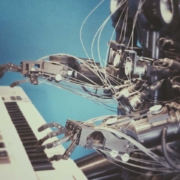Supply chain adaptability
Nature already teaches us. In rapidly changing circumstances, the ability to adapt is the best strategy. Whether it’s climate change, artificial intelligence or increasing consumer awareness.
Ripple effects.
Due to changes in trading structures and changing power relations in the world market, tariffs and agreements are renegotiated. Supply chains are coming under pressure as a result of climate change. These effects will ripple through supply chains. This can lead to paralysis of supply chains.
Designing supply chains with the ability to quickly adapt to bypass natural disasters or quickly reconfigure to accommodate shifts in costs or material availability due to changed rates has become critical to maintaining high levels of service.
This requires, for example, smart and intelligent purchasing systems that continuously assess the risk for the delivery of critical goods.
Digitization
Artificial intelligence progresses only to a limited extent, but this is mainly due to the unfamiliarity with possible applications. AI is still in its teens but will mature quickly. It will not be long before progress is made and better integration is achieved with procurement platforms. Such developments will help meet customer needs, create real-time efficiency, capture data networks and manage improvement plans.
Forrester research shows that 55% of organizations want to invest in AI by the end of 2019.
Using AI with smart procurement platforms will provide buyers with better insight and enable better supplier evaluation. It will help with orders, invoice processing and quick access to global information. Information from IoT can also be integrated.
Digital freight platforms that create online marketplaces will become increasingly important so that they can connect to carriers quickly and efficiently. It helps streamline processes and thereby reduce costs, risks and possible options to make them more available on the market.
Advance of robots
Robot technology is expected to reach a “tipping point” in 2019. The technical possibilities, improved connection with software systems offers ample opportunity to robotize processes such as order picking. Initially, robots will replenish warehouse workers, but the final switch will not be long in coming.
Gartner adds that by 2023, more than 30% of warehouse workers will be “supplemented” by “collaborative robots.”
People can then focus more on the things they are good at. Solve more complex deliveries or returns and maintain direct contact with customers and suppliers.
Ethics and transparency
Applying AI and robotization requires companies to think more about issues such as ethics and transparency in the decisions they make. Think of privacy-sensitive decisions, taking over jobs by robots will stimulate the social debate with all the associated risks for companies.
But also in the field of sustainability, it is important that companies take steps to protect their supply chains. Doing nothing is a dead end because the availability of raw materials is rapidly decreasing, supply chains will be disrupted by climate effects and the public and political views are now firmly pushing for sustainability. Businesses that are left behind may be confronted with strict legislation and, in the worst case, consumer boycotts. The need for rapid adjustment is even more important today than ever before.








